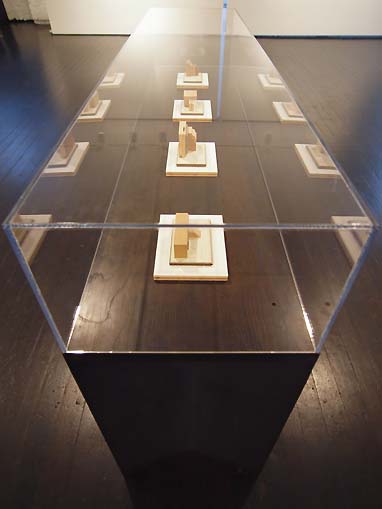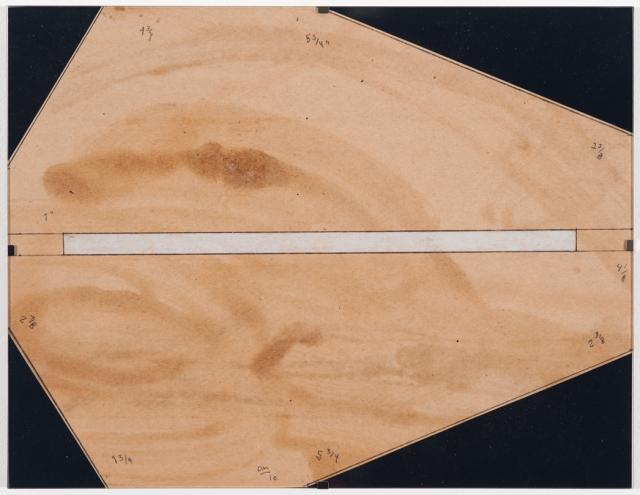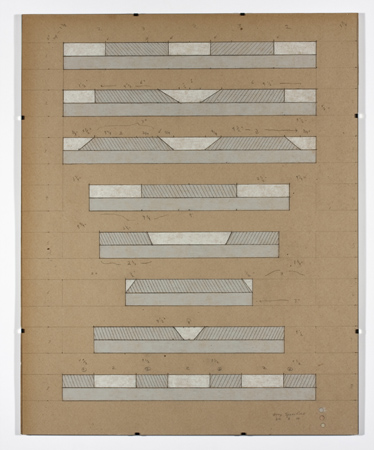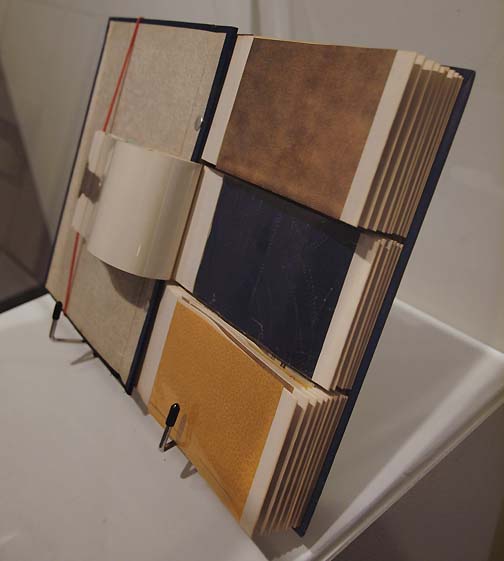
|
||
|
Portland art blog + news + exhibition reviews + galleries + contemporary northwest art
|
||
DE May's The Template Files at PDX Art of any genre's greatest strength and weakness is its ability to nearly become
something, without actually being forced to commit to fully becoming that thing.
Think of it as a butterfly just as it breaks free of the chrysalis... not a
moment before or after. It is a delicate moment between entropy and becoming
something new through accretion and artists like Richard Tuttle and Jackson
Pollock are masters of it.
 Untitled (exterior storage) [photo jeff jahn) Similarly, as one of the most adept artists on the West Coast DE May's work traffics in the concentrated residue of planning in contemplation. His meticulous notations, structural conglomerations and materials are brewed in a history that he always uses though erases somewhat. The elements of these relentlessly non-archival works seem to soak into one another then dry to a highly preserved state. As residue this is the sort of meticulous engineering of ephemera that after a lifetime or two becomes a priceless family heirloom like grandfather's old plans for a bridge or garden. Yet, here as art they don’t feel nostalgic or antique. Rather, it's like the viewer is asked to become an auditor of this collection of activity and May has simply opened his books. One highlight of May's The Template Files at PDX Contemporary is Untitled (exterior storage) consisting of numerous stacked blocks and fibers, which remind me of the models that city planners used to move around before computers.  Boundary Template (540) Yes there are touches of Robert Mangold, Agnes Martin, Gordon Matta-Clark (Untitled 528-530), Michael Heizer (Boundary Templates 540-546) and works reminiscent of sorts of working drawings Donald Judd's fabricators produced, but the only thing I can really compare May's works to are the funerary relics of pharaohs in that they seem so civic (and allegorical so) in comparison to other so call minimalist works. To walk into this exhibition is to experience the way things withstand and wither amongst the sands of time. 
Grey Specifics For instance, Grey Specifics looks like the sketch for an excavation, a pattern for a Navajo Rug, a Judd purchase order from Bernstein Brothers and an Agnes Martin all rolled into one. Certainly “Specifics” relates to Judd's Specific Objects but May's penchant for the gray area between language and object make it infinitely more provisional and difficult to pin down, perhaps because it flirts with not being art. Rather, Grey Specifics is the palimpsest of activity and has more to do with the pregnant cognition of the viewer when confronted with transmuted material rather than a fetish for geometries. For those reasons Grey Specifics is my favorite piece in the show. This is a show of mysteries and there is no Rosetta Stone for Dan May's work. Every single work is angular, quiet and seems to anticipate the viewer’s response, yet yields only the persistent sense that there is always another project. They remind me of what it's like to visit a clothing designer or architect's atelier, only without the obligatory highly managed sales presentation. It's an interesting duality of this work, one which doesn't look like it is for sale but definitely is. Major collectors like Werner Kramarsky may have an affinity for May's work because the artist himself is quite a collector... like Joseph Cornell, Andy Warhol and Duchamp. Perhaps DE May is a collector of the moment ideas hold some sort of promise... it's a tender moment that many creative types relish, the aha moment before the really arduous work of executing a plan. Only the fanciful schematics of Paul Klee and the delicious diagonals of Richard Diebenkorn seem relevant (because they are so poetic) and still May's work is so different, in the way that a coffee house punch card is different than a business card. May's work is that punch card and ultimately the work draws you into his assumed process, more than his compositions, which he wisely mutes. Thus, works like Note Book feel more like found objects rather than exercises of his artistic will (though it clearly is with its impeccable design touches). This counter response is a key feature in his practice and Dan May is like an experienced hunter who doesn't leave many tracks, making him all the more effective and in tune with an environment which supplies him something to hunt.  Note Book In the decade plus I've lived here DE May has produced some of the most consistently good shows in Portland, but this show may be his best to date. held over till January 8th Posted by Jeff Jahn on January 06, 2011 at 15:46 | Comments (0) Comments Post a comment Thanks for signing in, . Now you can comment. (sign out)
(If you haven't left a comment here before, you may need to be approved by
the site owner before your comment will appear. Until then, it won't appear
on the entry. Thanks for waiting.)
|
| s p o n s o r s |
 |
 |
 |
 |
 |
 |
 |
 |
 |
 |
 |
 |
 |
 |
 |
 |

|
Site Design: Jennifer Armbrust | • | Site Development: Philippe Blanc & Katherine Bovee | |

